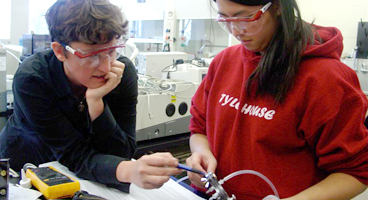Document Type
Article
Publication Date
8-2008
Publication Title
Ear and Hearing
Abstract
Objectives:
The development of acoustic reflectance measurements may lead to noninvasive tests that provide information currently unavailable from standard audiometric testing. One factor limiting the development of these tests is that normal-hearing human ears show substantial intersubject variations. This work examines intersubject variability that results from measurement location within the ear canal, estimates of ear-canal area, and variations in middle-ear cavity volume.
Design:
Energy reflectance (ER) measurements were made on nine human-cadaver ears to study three variables. (1) ER was measured at multiple ear-canal locations. (2) The ear-canal area at each measurement location was measured and the ER was calculated with the measured area, a constant area, and an acoustically estimated area. (3) The ER was measured with the middle-ear cavity in three conditions: (1) normal, (2) the mastoid widely opened (large air space), and (3) the mastoid closed off at the aditus ad antrum (small air space).
Results:
Measurement-location effects are generally largest at frequencies below about 2000 Hz, where in some ears reflectance magnitudes tend to decrease systematically as the measurement location moves away from the tympanic membrane but in other ears the effects seem minimal. Intrasubject variations in reflectance due to changes in either measurement location within the ear canal or differences in the estimate of the ear-canal area are smaller than variations produced by large variations in middle-ear cavity air volume or intersubject differences. At frequencies below 2000 Hz, large increases in cavity volume systematically reduce the ER, with more variable changes above 2000 Hz.
Conclusions:
ER measurements depend on all variables studied: measurement location, ear-canal cross-sectional area, and middle-ear cavity volume. Variations within an individual ear in either measurement location or ear-canal cross-sectional area result in relatively small effects on the ER, supporting the notion that diagnostic tests (1) need not control for measurement location and (2) can assume a constant ear-canal area across most subjects. Variations in cavity volume produce much larger effects in ER than measurement location or ear-canal area, possibly explaining some of the intersubject variation in ER reported among normal ears.
Volume
29
Issue
4
First Page
651
Last Page
665
DOI
10.1097/AUD.0b013e318174f07c
Version
Author's Accepted Manuscript
Recommended Citation
Voss, Susan E.; Horton, Nicholas J.; Woodbury, Rebecca R.; and Sheffield, Kathryn N., "Sources of Variability in Reflectance Measurements on Normal Cadaver Ears" (2008). Engineering: Faculty Publications, Smith College, Northampton, MA.
https://scholarworks.smith.edu/egr_facpubs/147


